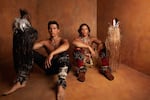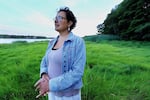In 2012, the Swinomish and Tulalip photographer and storyteller Matika Wilbur embarked on an enormous project: to travel the country, talking to and photographing people from what was, at the time, 562 federally recognized tribes.
She ended up traveling 600,000 miles over a decade, visiting all 50 states, and gathering the stories and images of more than a thousand Indigenous people.

Darkfeather Ancheta, left, with her nephew, Eckos Chartraw-Ancheta, and sister, Bibiana Ancheta, on the shore of Tulalip Bay. Seattle photographer Matika Wilbur captured images of 562 federally recognized tribes for her book "Project 562."
Matika Wilbur
Wilbur’s goal for the project was to counteract the one-dimensional stereotypes and caricatures that have dominated the representation of Native people for centuries.
“We’ve told a story that doesn’t uplift the contemporary complexity of our Indigenous intelligence or our strength or our resiliency or our contributions to the society, but rather a pre-1900s narrative that’s deeply damaging to the psyche of our youth,” she said. “We need different images. We need positive images for our own youth to be able to see themselves differently.”
The impetus for the project came when Wilbur was a teacher at a tribal school and was asked to create a curriculum to teach students about their history.
“I went to my elders back to the principal of my school and I said, ‘You know, there really isn’t something that I can teach. There aren’t the materials,’” she said. “‘And I can’t use these images that I found on Google. And I certainly can’t use these terrible images created by Edward S. Curtis. So what should I do?’ And they said, ‘You should go make the book then.’ And so, I sort of was just doing what I was told.”

Twin brothers Raven, left, and Free Eagle Borsey are pictured at the Power Paddle to Puyallup moments before taking the floor to dance.
Matika Wil
Wilbur said she began the project centering her own experience as an Indigenous person from the Pacific Northwest but quickly learned for herself the diversity of Native experiences in the United States.
“People started telling me about their land-based identities, about how they live within the Four Sacred Mountains or they are the People of the Tall Pine Trees and those identities and coming to understand those traditional identities that were in place, pre-colonization — are still in place — would impact me in ways that I couldn’t have imagined,” she said.
The book features images of Indigenous people of all ages in both traditional regalia and everyday clothes. Wilbur allowed her subjects to choose how they wanted to be depicted.

Wampanoag journalist Paula Peters chose to be photographed at a marsh near her home in Cape Cod.
Matika Wilbur
“I would ask people where they wanted to be photographed, how they wanted to be photographed, what they wanted to be wearing, what they wanted to talk about in their interview, before interviewing them because I think it’s very patriarchal and colonial to believe that I know what would be the best thing to ask them,” she said. “I think sharing agency is critically a part of this work.”
When asked where and how she would choose to be photographed, Wilbur emphasized her own connection to the land.
“I think of myself as a person of the tide, and I think of myself as my grandmother’s granddaughter. My mother has this tree on our family property — we live on Wilbur Lane. It’s really our family property and it’s where my afterbirth has been placed and also my daughter’s afterbirth, my mother’s, my grandmother’s. And so that cedar tree is really important to us. So I think maybe I would want to be photographed there,” she said. “Because I think my identity — who I am — is very much connected to those women, to those matriarchs in my life.”
Wilbur spoke to “Think Out Loud” host Dave Miller. To listen to the full interview press the play arrow below.

Isabella and Alyssa Klain raise their fists in the air on the salt flats outside their home in Salt Lake City, Utah.
Matika Wi
